Plum is well known to us since childhood.
Remember enjoying its tart taste and delicate juicy pulp, refreshing coolness thick juice with a pleasant sourness.
And the story of the stolen plums, the bones of which the boy threw out the window, pops up in his memory. This once again emphasizes how great was the temptation of the taste of a tasty fruit.
Some historical facts
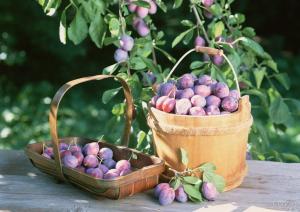 The plum season opens in our latitudes closer to autumn.
The plum season opens in our latitudes closer to autumn.
A little earlier, the sale of plums brought from the places of its growth begins.
And the original homeland of the plum tree is considered the territory between Altai and Transcaucasia, where the modern plum hybrid was cultivated from wild thorns and cherry plums.
Plum trees can be found in every garden plot or garden - from undersized one and a half meter shrubs to sprawling giants five meters in size.
This is a fruit tree of the almond, or stone fruit family, so the closest relatives are:
- Cherry (),
- cherry plum (it is written about the benefits and harm to the body),
- apricot()
- peach.
Plum is unpretentious, and easily adapts to any climate and soil. At the time of flowering, it is difficult not to notice the beauty - the tree is shrouded in a fragrant haze of white or pink flowers.
The fruits are varied in shape, size and color - depending on the variety, of which there are at least 2000.
Yellow and blue, purple and red, green and blue - the size of quail egg and more, up to the child's fist.
The beauty of chemistry
Plum fruits are an example of a dietary product. Excellent taste qualities successfully supplemented low calorie, only 30 calories per 100 grams of product.
The fleshy skin has a lot of useful fiber and pectin necessary for healthy digestion and peristalsis.
organic or fruity acids saturate juicy fruits with subtle flavors and are actively involved in digestion.
Under their action, bile secretion is stimulated (read how to remove cholesterol stones in the gallbladder) in the small intestine, this activates peristalsis and helps digest food.
Plum leads in content potassium required:

Anti-clotting coumarins found not only in ripe plum fruits, but also in leaves (read how to treat thrombophlebitis of the lower extremities on the page).
The ability to expand the coronary vessels makes them a natural therapeutic agent for disorders of cerebral circulation.
Calcium and phosphorus in the composition of the plums are useful for bones, zinc, copper and chromium - have a positive effect on the composition of the blood.
Plum fruits are rich in fluorine essential for dental health and caries prevention.
Present in plums and deficient in our geography iodine. Therefore, plums are boldly considered to be a means of preventing iodine-deficiency conditions, such as wild strawberry ().
"Vitamin plum" cocktail:
- vitamin A many in the fruits of light shades.
It is important for sharp vision, maintains muscle tone and is responsible for epithelialization of the skin. - Plum pulp is a rich source vitamin PP, which strengthens the walls of blood vessels, thereby normalizing blood pressure.
This vitamin is resistant to high temperatures and is preserved during cooking. - Vitamin C- A well-known antioxidant that neutralizes free radicals.
Without ascorbic acid, without which cellular metabolism is impossible, it maintains health, gives the skin radiance and youth. - According to the content of vitamins of the group B, E and K Plum confidently enters the top of the strongest among fruits.
fruit properties
Plum is known as a mild and effective laxative. First of all, this applies to prunes (which healthier than dried apricots or prunes written), which is obtained from the Hungarian variety.
For atonic constipation plums, compotes and juices containing pulp are an indispensable natural remedy that does not have side effects.
The ability of plums to remove cholesterol is used in the treatment of atherosclerosis and high blood pressure.
Regularly including plums on the menu can prevent myocardial infarction.
diuretic effect, produced by plums, is used for heart and kidney damage, gout, thanks to it, the body safely gets rid of excess fluid and excess salt.
Plum is known for its ability to increase appetite by stimulating the production of enzymes in the gastrointestinal tract.
It is used in the diet therapy of digestive diseases and as a general tonic for debilitated patients with anemia.
It is also useful in baby food. Dietitians recommend diversifying children's menu plums during the periods:

The healing effect of plums has shown itself in metabolic diseases:
- arthritis,
- rheumatism,
- gout.
Plum and products from it cope with overweight and obesity without disturbing the metabolism. She is a full participant in weight loss diets ().
Useful plums and iron deficiency anemia. Having a huge supply of vitamin C in their arsenal, they stimulate the synthesis of new red blood cells - erythrocytes.
Wound healing ability of decoctions plum leaves are used in folk medicine and surgical practice
For the female body

For athletes and not only

Choosing healthy fruits
Today, plums are available year-round, but plums that ripen in May-September will bring maximum benefit.
They are not only fragrant and tasty, but also filled to the brim with health benefits. How can you tell if a fruit has been chemically treated?
A light, whitish coating on the fruit is indicative of natural ripening (or minimal use of chemicals).
Plum softness is a warning sign, as well as the "bruises" on her barrels.
A ripe and edible plum is resilient and elastic.
 It yields to finger pressure and has a pleasant sweetish-fruity smell.
It yields to finger pressure and has a pleasant sweetish-fruity smell.
Unripe fruits quickly reach ripeness at room temperature.
After that, they are moved to the refrigerator and eat as needed.
Culinary delights
Plum is a tasty product for gourmets and cooks. She pleases culinary specialists with accessibility, original taste and great benefit.
Prolong the season of fresh plums help harvesting for future use:
- dried plum- prunes - keep all the qualities of fresh, it is stored for a long time, without requiring a lot of space and special conditions;
- frozen plum- whole or in halves - another option for easy and complete preservation.
A chic set of vitamins and minerals during defrosting goes to a zealous owner or hostess.
Both variants:
- tasty and practical filling for pies,
- additive for salads and desserts,
- just a treat.
 Heat treatment allows you to cook the most delicate, healthy:
Heat treatment allows you to cook the most delicate, healthy:
- jams,
- fragrant kissels and compotes,
- clear jellies,
- excellent jam.
The myth that it can be poisoned by hydrocyanic acid from plum pits, is untenable.
Acid decomposes already at 70 degrees heating, so boiling and sterilization guarantee its complete elimination in finished products.
Another use of plums is the main semi-finished product for marshmallows and marmalade.
The specific taste with sourness is used in sauces and marinades. Everyone knows and loves Tkemali sauce - it contains plum pulp.
Plum is an indispensable ingredient in the national Jewish dish "tsimes".
Contraindications and caution
There are few obstacles on the way to the table at the plum, but it is better to remember them.
 Breastfeeding mothers are advised be careful with prunes.
Breastfeeding mothers are advised be careful with prunes.
It can provoke colic in an infant, especially in the first months of life.
If the desire to try the plum still remains, it is better to eat 1-2 pieces in the morning - to track the reaction of the baby's tummy.
Suffering diabetes it is better to refrain from draining, at least in in large numbers. The reason lies in the calorie content and high glycemic index.
The benefits of plums in renal pathology are limited. In diseases of the excretory organs - glomerulonephritis and the accompanying renal failure, it will do more harm than good.
Watch a video on the beneficial properties of plums. In what form, it most fully reveals all its healing qualities.
– one of the most popular fruits for both children and adults. In addition to the fact that many favorite desserts are prepared from it, the fruit also has many healing properties. Moreover, the plum does not lose its properties during any processing.
Plum: nutritional value, vitamins and minerals
 The plum is rightly considered dietary product, her the nutritional value is about 30 kcal per 100 g. Moreover, the plum is just a storehouse of vitamins: it contains vitamins A, C, PP, E, B1, B2, B6 and P. And what useful chemicals and compounds the plum does not contain! It contains organic acids, malic and citric acids, dietary fiber and fructose. The fruit contains fiber, pectin and antioxidants. Also, the fruits are rich in trace elements such as iodine, zinc, fluorine, calcium, manganese, chromium, copper, phosphorus. And the potassium content per 100 g of the product is 215 mg.
The plum is rightly considered dietary product, her the nutritional value is about 30 kcal per 100 g. Moreover, the plum is just a storehouse of vitamins: it contains vitamins A, C, PP, E, B1, B2, B6 and P. And what useful chemicals and compounds the plum does not contain! It contains organic acids, malic and citric acids, dietary fiber and fructose. The fruit contains fiber, pectin and antioxidants. Also, the fruits are rich in trace elements such as iodine, zinc, fluorine, calcium, manganese, chromium, copper, phosphorus. And the potassium content per 100 g of the product is 215 mg.
Did you know? The British love for the plum is expressed in the fact that the word "plum" is present in many names of various establishments, for example, a bar called "Wild Plum" (Wild Plum) in Edinburgh or a bar called "Yellow Plum" (Yellow Plum) in London, which is not once visited by Winston Churchill.
What is useful plum
Plum benefits primarily in that the fruit is a quality laxative. It gently helps to regulate bowel function without causing inconvenience to the patient. Even doctors advise her to people with intestinal atony and suffering from constipation. The constant use of plums significantly reduces the level of cholesterol in the blood.
Benefits of plum leaves
 Plum leaves also have useful properties, and, perhaps, their only contraindication is the individual intolerance of the components. The main component in the composition of the leaves of the fruit is coumarins. These substances have an emollient effect: they dilute thickened blood, tone up the walls of blood vessels and greatly alleviate the condition with rheumatism and gout, as lotions. Also, with the help of infusions from plum leaves, abscessing and festering wounds are treated, thanks to the same coumarins.
Plum leaves also have useful properties, and, perhaps, their only contraindication is the individual intolerance of the components. The main component in the composition of the leaves of the fruit is coumarins. These substances have an emollient effect: they dilute thickened blood, tone up the walls of blood vessels and greatly alleviate the condition with rheumatism and gout, as lotions. Also, with the help of infusions from plum leaves, abscessing and festering wounds are treated, thanks to the same coumarins.
Useful properties of fruits
Consider why plum fruits are so useful for our body. Plums are certainly useful for people who are overweight and have metabolic disorders who want to lose weight, because they have a diuretic effect and perfectly remove from the body. extra salt, cholesterol and are easily absorbed by the body. In addition, the plum also acts as a laxative, removing toxins and toxins from the body. Plums are useful for people suffering from hypertension, they are useful for rheumatism. Plums with a mild effect alleviate the condition of patients with stagnation in the gallbladder, increasing the outflow of bile.
Important! Potassium helps muscles receive impulses that stimulate them to contract. Thus, the use of fruits also supports cardiac activity.
Medicinal properties of plums, how the fruits of a stone plant are used in folk medicine
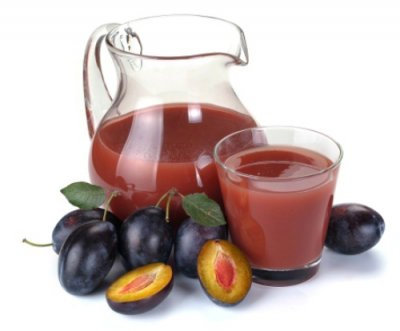 The question of whether a plum weakens or strengthens has long been studied by folk medicine. Most often, it is herbalists and healers who recommend solving problems with metabolism and problems of the intestinal tract with the help of plums. Juice with pulp significantly improves intestinal motility, in addition, it is a store of many vitamins, including vitamin C, which is necessary for the prevention of viral infections. Often ethnoscience recommends plums for those who have kidney problems: plums perfectly remove salts. In many cases, preventive use of plums is carried out to relieve unpleasant symptoms of skin diseases or skin injuries.
The question of whether a plum weakens or strengthens has long been studied by folk medicine. Most often, it is herbalists and healers who recommend solving problems with metabolism and problems of the intestinal tract with the help of plums. Juice with pulp significantly improves intestinal motility, in addition, it is a store of many vitamins, including vitamin C, which is necessary for the prevention of viral infections. Often ethnoscience recommends plums for those who have kidney problems: plums perfectly remove salts. In many cases, preventive use of plums is carried out to relieve unpleasant symptoms of skin diseases or skin injuries.
Interesting! For the first time, a plum came to Russia thanks to Tsar Alexei Mikhailovich in 1654. The tree first grew in the royal garden, and from there it spread through the courtyards of Russia, although it gained the greatest popularity in growing plums at the end of the 18th century.
 The healing properties of plums are also appreciated by modern cosmetology. The pulp of the fruit is successfully used as a rejuvenating, tonic and nourishing agent for the skin. Minerals in the composition of plums strengthen and restore hair and nails, give dull hair shine and softness. Beta-carotene smoothes early wrinkles, prevents the loss of collagen, which is necessary to maintain youthful skin. The pulp is used to make creams, masks, lotions and tonics. And what valuable substances contain oil and plum seeds! Plum oil contains palmitoleic, stearic, oleic, linoleic, eicosanoic acids. In addition, it is rich in iodine and sitosterol. The presence of antioxidants and fatty acids, vitamin E and minerals softens and smoothes rough skin, while being easily absorbed. Plum pits used for the manufacture of scrubs contain copper, iron, calcium, magnesium, zinc, phosphorus, which allows not only to cleanse the skin qualitatively, but also to nourish it.
The healing properties of plums are also appreciated by modern cosmetology. The pulp of the fruit is successfully used as a rejuvenating, tonic and nourishing agent for the skin. Minerals in the composition of plums strengthen and restore hair and nails, give dull hair shine and softness. Beta-carotene smoothes early wrinkles, prevents the loss of collagen, which is necessary to maintain youthful skin. The pulp is used to make creams, masks, lotions and tonics. And what valuable substances contain oil and plum seeds! Plum oil contains palmitoleic, stearic, oleic, linoleic, eicosanoic acids. In addition, it is rich in iodine and sitosterol. The presence of antioxidants and fatty acids, vitamin E and minerals softens and smoothes rough skin, while being easily absorbed. Plum pits used for the manufacture of scrubs contain copper, iron, calcium, magnesium, zinc, phosphorus, which allows not only to cleanse the skin qualitatively, but also to nourish it.
How plums are used in cooking
Plum is quite popular in cooking. From the fruits for the winter, preserves, jams, marmalade, marmalade and marshmallow, compotes and juices are harvested. Fresh plums are used as a filling for pies and pies, impregnations for cakes and muffins are prepared. Mass is prepared from plums delicious desserts: puddings, mousses, jellies, plum candies, purees and candied fruits. From plums it turns out good sauce for meat and poultry, gravy for second courses, fresh plums go well in fruit and vegetable salads.
Plums are dried, dried, pickled, frozen and soaked. Not without plums and the alcohol industry: vodka, wine, liqueurs, tinctures and much more. What is especially valuable about this fruit is that everything that plums are useful for the body does not disappear after heat treatment of fruits or their drying, drying. As in cosmetology, plum oil is used in cooking with might and main: its thick almond aroma and pleasant aftertaste resonated with confectioners in the preparation of sweets, pastries and cakes.
Plum: harm and contraindications
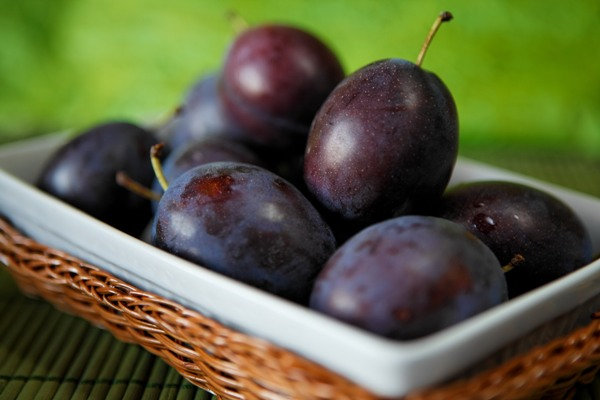 Like any other product, plums, in addition to useful properties, have contraindications. Plums are absolutely contraindicated in diarrhea. Contraindicated in large quantities people with severe diabetes. It is undesirable to drink plum juice for gout. It is not recommended to give puree or juice with pulp to children under one year old. People with hyperacidity stomach should eat plums in minimum quantities. Allergy sufferers should listen to their feelings.
Like any other product, plums, in addition to useful properties, have contraindications. Plums are absolutely contraindicated in diarrhea. Contraindicated in large quantities people with severe diabetes. It is undesirable to drink plum juice for gout. It is not recommended to give puree or juice with pulp to children under one year old. People with hyperacidity stomach should eat plums in minimum quantities. Allergy sufferers should listen to their feelings.
Attention!Children's digestive organs will not be able to digest the plum, which will cause severe upset and pain in the intestines and stomach.
– a healthy and vitamin fruit, if you eat it in reasonable quantities, you will saturate your body with vitamins, minerals, and the necessary energy.
Was this article helpful?
Not really
Perhaps it is difficult to find a person who will remain indifferent to the taste of juicy ripe plums. A truly ripe plum, regardless of variety, has a slight teasing aroma and a rich sweet taste with a slight sourness that gives this fruit some piquancy. Plums are common and very popular in many countries of the world. Plums are initially varied in shape, color, size and taste. And thanks to selection today, even the most discerning gourmet will be able to find a variety of plums that fully meets all his wishes.
Plum is valuable not only for its taste. Its fruits contain useful substances. And depending on how much and how correctly you use the plum, it can be beneficial or harmful.
The benefits of plums for weight loss
It's no secret that the most effective effect in the fight against excess weight is not diets, but a healthy lifestyle and a balanced diet. Many doctors and nutritionists recommend including plums in your daily diet. This is not surprising, because the plum contains many useful substances. Here are some of them:
- Cellulose. Normalizes bowel function.
- Potassium. Removes excess fluid.
- Vitamins. Contribute to strengthening the immune system.
- Macro- and microelements. Healthy skin, nails, hair.
- Pectins. Helps to remove waste and toxins from the body.
Thus, the benefits of plums for weight loss are obvious: you will not only lose extra pounds and centimeters, but also acquire a healthy, flowering appearance and excellent health.
Health Benefits of Plums
Even the timing of plum consumption can affect the result. For example, if you eat a few fruits before a meal, your appetite will improve. This option is unlikely to suit those who seek to part with excess weight. It is better to enjoy a dessert of fresh plums. In this case, digestion improves, due to the intake of fructose and vitamins, there is a surge of strength and good mood.
Eating 3-6 plums a day stimulates bowel function. If you want to cleanse the body, increase daily dose drain.
So, you need to remember that everything is good in moderation and on time. And in this case, you can avoid harm and get only health benefits from plums.
plum diet
One of the successful diet options for weight loss on plums can be considered the following:
- Breakfast: , half an apple or peach, a glass of plum juice.
- Dinner: chicken bouillon with croutons, salad fresh vegetables With olive oil, green tea, 5-6 plums.
- Dinner: low calorie yogurt, 7-10 plums.
During the day, you need to drink at least two liters of fluid.
It is also worth noting that plums are included not only in weight loss diets. Plums are no less useful for hypertensive patients, people with kidney diseases. of cardio-vascular system.
Plum and vitamins

During ripening, the plum accumulates in itself great amount vitamins of the PP, B2,. Plum is also unique in that most of the vitamins are preserved in the fruit even during processing. Therefore, plum juices and compotes, jam and jam, and especially just frozen plums are so useful. This wonderful fruit gives us health and great taste all year round.
The benefits of plums during pregnancy
The benefits of plums during pregnancy are indisputable. It perfectly fights puffiness, has a slight laxative effect, and helps with nausea. In addition, plums contain a lot of potassium, which is necessary in the formation of the cardiovascular system of the unborn baby.
Hello dear readers. Today I wanted to talk about healthy eating. On the agenda is such a fruit as a plum, we will also consider the useful properties and contraindications of plums. Today the children were at the market and bought delicious plums. After all, the plum is not only tasty, fragrant, but also has useful and medicinal properties for our body. And besides, I really love fresh plums, it’s only a pity that the season of fresh plums ends very quickly and you need to have time to eat plenty of plums, well, unless of course you have contraindications to eating plums. This year we have a really good harvest for plums, I know they simply didn’t exist last year, but this year there are a lot of them on every tree, and they are sold on the market at every corner. Plums are eaten as in fresh, and they cook jam, jam, compote from them, prepare jelly, pickle plums, and various desserts are prepared from plums. . A few years ago, a friend gave me a recipe for jam from plums with cocoa, I cooked it, you can grease the cake with this jam, use it as a start for pies, pies. But, this year plum jam I don't cook, I cooked strawberries, strawberry jam, and plums will be eaten fresh like that. Juicy, sweet, sweet and sour, blue, white, purple, plums are now for every taste. It all depends on the variety of plums, of course. The ripening season of this fruit falls on August-September. At this time, we eat plenty of plums and make them various blanks for the winter.
The calorie content of plums is only 40 kcal per 100 grams, as you can see, plums are quite low calorie fruit, so it is the best suited for unloading days.
Plum useful properties.
- Plums are useful to eat with rheumatism, with metabolic disorders.
- Plums contain a lot of potassium, 215 mg per 100 grams. Potassium is very good for the heart, nervous system, it is involved in the transmission of nerve impulses during muscle contraction.
- Plums help with stagnant processes in the gallbladder and enhance the separation of bile.
- Plums remove cholesterol from the body.
- Plums remove toxins from the intestines.
- Beneficial features plum shows constipation. Plum has a mild laxative effect.
- It is recommended to eat plums for hypertension.
- Plums have a diuretic effect on our body, thus helping to remove excess fluid and salt from the body.
- Plum is not only easily digested, but also easily absorbed by our body.
- A compote of dried plums is an excellent remedy at high temperatures. But how to deal with a cold, you can learn from my article "."
- Plums are rich in vitamins dietary fiber, organic acids, fructose, malic and citric acid, carbohydrates, vitamin: A, C, PP, E, B1, B2, B6.
- Plums also contain trace elements such as iodine, zinc, fluorine, calcium, manganese, chromium, copper, phosphorus.
Plum useful fruit, even take for the prevention and treatment of the gastrointestinal tract. And plums, due to their composition, contribute to good bowel function. Plum is a wonderful, natural, one might say, vitamin. But let's see what contraindications plum has.
Plum contraindications.
- Plums are contraindicated in diarrhea.
- Also, they should not be eaten by diabetics, as plums contain a lot of sugar.
- If you eat plums excessively, you may experience pain in the intestines, as well as diarrhea.
- And if a person has such a disease as gout, then doctors do not recommend drinking plum juice.
- With caution, plums can be eaten and drunk by young children, as this can cause rumbling and pain in the stomach due to its laxative effect.
- Use caution with plums in case of high acidity.
- Plum is contraindicated in case of individual intolerance to the fruit or allergy to plums.
How many plums can you eat per day?
I don't try to abuse plums. Although I know people who can eat plums in kilograms. I eat 5-6 plums a day, this is without harm to health. Since plums cleanse the intestines very well, and everyone’s intestines are different, some run to the toilet after 10 minutes, others after a few hours, and still others will eat a kilogram during the day and can only go to the toilet in the evening.
Plum useful, tasty, juicy, sweet fruit. Useful properties and contraindications are known to you. If you have no special contraindications to the use of plums, eat them to your health. But, as they say, everything is good in moderation.

Plum belongs to the rose family. This fruit plant began to be grown in Asia Minor and the Caucasus. A little later, it appeared on the territory of many countries, including Russia. The plant has many varieties, each of them has its own size and color of the fruit. Plums are eaten in kind, are prepared from it various jams, juices, compotes, added to the filling for pies. Wine made from such fruits and spirit tinctures are highly valued.
Plum leaves are also used to make teas. The usefulness of such drinks has been known since ancient times. They have a calming and restorative effect. Many people know how plums are useful for the body. Such fruits are recommended for use in cardiovascular diseases, they also have a beneficial effect on the digestive tract.
Varieties of plums
The plant has many varieties. Plum flavors are also varied. What are the benefits of these fruits? It directly depends on the variety and the place of their growth. Plum includes the following types:

Beneficial features
rich vitamin composition has a plum. Useful properties and contraindications of this plant depend on the variety. The soil also plays a significant role. The predominance of a certain type of minerals in the earth is directly reflected in the composition of the fruit.
What are the benefits of plums for the body:

The chemical composition of plums:
- vitamins A, E, P;
- iron;
- potassium;
- copper;
- zinc;
- acids: folic, nicotinic;
- sucrose, glucose;
- organic acids: citric, malic, oxalic.
Who is contraindicated in plums
Although plums are very useful product nutrition, but they still have contraindications:
- They should not be used by children under 1 year old, as the product causes abdominal pain, upset stool and increased gas formation.
- For the same reason, they are not recommended for breastfeeding mothers.
- People with peptic ulcers of the stomach and duodenum, as well as with high acidity, this product is also prohibited.
Canning plums
Many housewives How useful such fruits are, mankind has known for a long time. After all, such a product retains useful properties even when heat treatment. From plums prepare jam, compote, juice. There is a lot various recipes conservation of these fruits. They are closed whole with or without a stone, mixed with other fruits and berries. Most popular recipes:
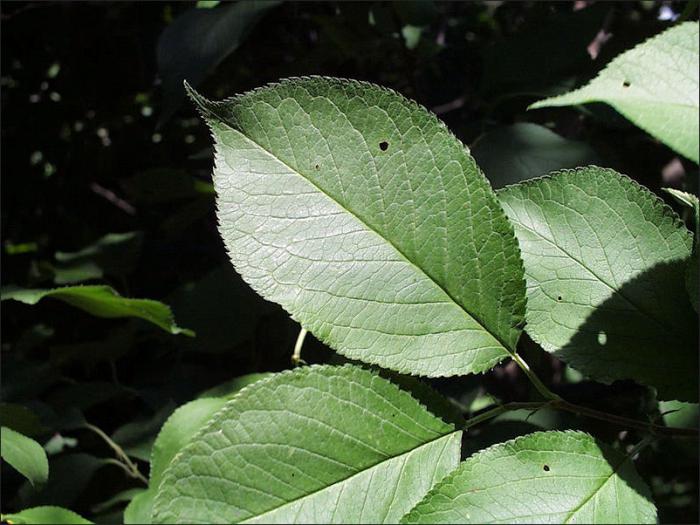
How are plum leaves used?
In addition to fruits, plum leaves are also of particular value. Useful properties of this product:
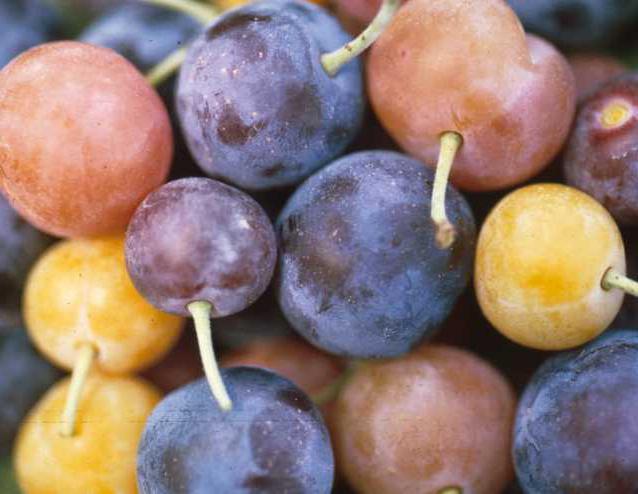
These leaves are used as medicinal teas and various lotions, compresses. Drinks have a general strengthening effect, and compresses are used for local treatment. There are no contraindications for this product.
The use of plums in childhood
Many parents wonder if it is possible to give plums to children. How useful are these fruits? Plum is very nutritious product, but its use in childhood should still be limited. Up to 1 year it is generally not recommended to give. side effect v this case is increased gas formation and intestinal colic. At an older age, it is also not recommended to abuse this product, otherwise diarrhea is guaranteed. What is useful plum for children?
- It has a mild sedative effect and provides sound sleep.
- Stimulates the work of the intestines, helps to get rid of constipation.
- Provides a growing body with many useful substances.
- Has a wound healing effect.
Do not use plums for babies with stool disorder, as well as diseases of the digestive tract associated with high acidity.


